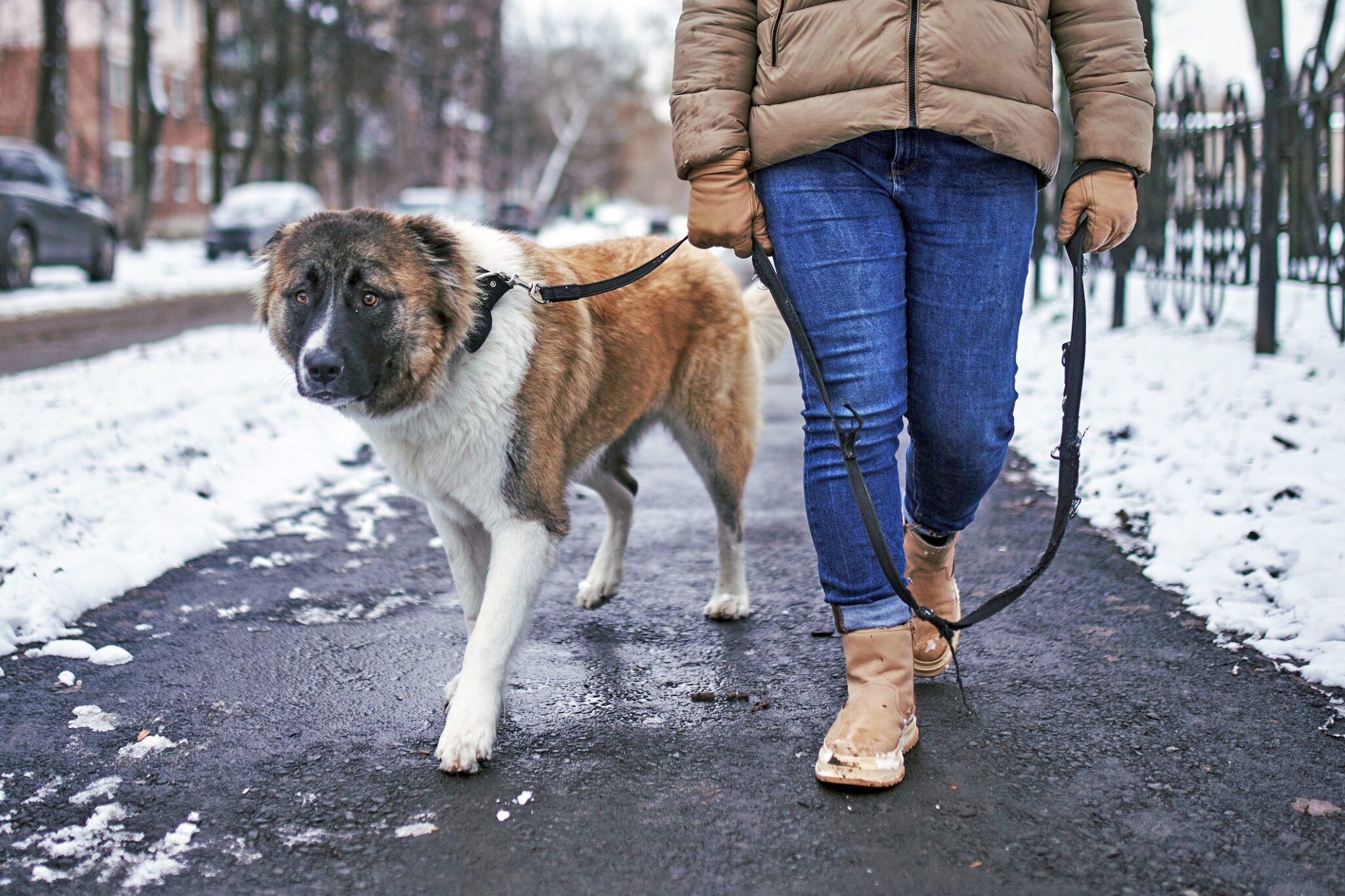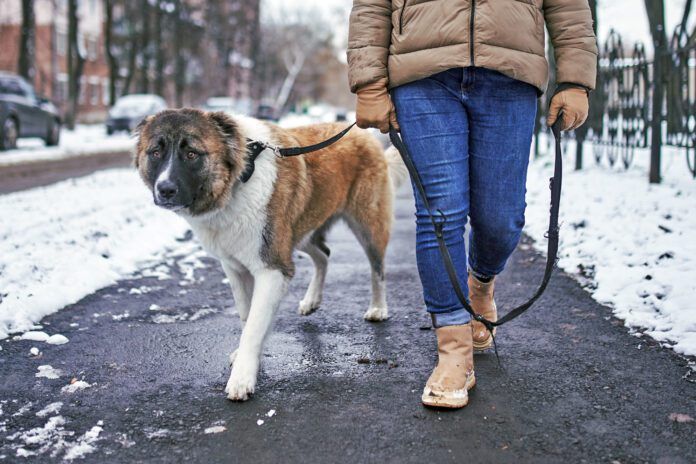While winter can be a wonderland for both humans and our dogs, with picturesque snow-covered walks and hikes, it can also be a slippery slope. Literally. While we enjoy the season, it’s important to be mindful of the dangers lurking beneath the snow. Ice is bad for dogs because they can slip just as we do, but the solution isn’t using traditional ice melt, rock salt, or ice salt. These common household items can injure your dog’s paws and can be toxic if ingested.
Pet-friendly ice melt options do work. They’re readily available and won’t harm your dog. Consider these options:
- Sand or kitty litter are natural materials that provide traction without the use of harmful chemicals. The downside: They don’t melt ice and are messy.
- Sugar beet- or beet juice-based products are less toxic to pets and can be effective at melting ice. The downside? Choose a product specifically labeled pet-safe, as some beet-based products may still contain harmful ingredients.
- Potassium chloride-based products are generally less harmful to pets than traditional rock salt, so potassium chloride-based ice melt is a good option for pet owners. The downside? They can still irritate paws and may be less effective at melting ice in very cold temperatures.
While you can’t control what your town or neighbors use to treat icy roads and walkways, you can control what you put down on your driveway, steps, and walks. These five safe ice melt alternatives, are suggested by Beth Turner, DVM, a Colorado-based veterinarian:
- Safe Paw: Made with a dual-effect compound that is said to work quickly to melt ice and prevent re-icing.
- Just For Pets A chloride-free formula, listed as safe for pets and easy to use.
- Green Gobbler: A pet-safe ice melt product that the manufacturer designed to work well in spreaders.
- Natural Rapport: The manufacturer claims, its ice melt is pet-friendly thanks to a proprietary organic formula to reduce corrosion and is safer for pets, children, and the environment.
- Safe-T-Pet: Safe-T-Pet is a salt-free ice melt developed with veterinarians to be safer for dogs, people, plants, and surfaces than plain salt, according to the company.
These products tend to be more expensive than traditional ice melt, or rock salt, but you should be aware of the risks associated with these choices.
Traditional Ice Melt
While you can use the cheaper alternatives, it’s wise to keep your pets away from those areas. The risks introduced by ice melt fall into two categories. According to the ASPCA Animal Poison Control Center (APCC), licking small amounts of ice melt off their paws or treated ground is unlikely to cause serious problems, but it does introduce a variety of health risks. The second, more serious concern is when a dog ingests a large amount of ice melt directly from the container, which could be fatal.
University of Illinois Veterinary Medicine South Clinic reports that dog owners need to look out for exposure to ice-melting products and react quickly if their dogs accidentally consume these products by eating treated snow or licking the products off the pads of their feet.
“Ice-melting products are usually made up of different kinds of salts, containing magnesium, potassium, calcium or sodium,” writes Dr. Gene Pavlovsky, director of the clinic. “Ingestion can cause vomiting and diarrhea, sometimes severe enough to cause dehydration or even tremors and seizures, depending on the amount ingested and size of the pet.”
As mentioned, popular ice-melt products usually contain chemicals, which can cause a variety of health problems if ingested, including:
- Gastrointestinal upset, which can lead to vomiting, diarrhea, and loss of appetite.
- Dehydration, due to excessive salt intake, can be serious if left untreated.
- Kidney failure, due to ingesting large amounts of ice melt.
- Paw irritation, caused by direct contact with ice melt can irritate your dog’s paw pads, causing pain and possible infection.
The American Veterinary Medical Foundation recommends that, when you’re out with your dog, you check her paws frequently for signs of cold-weather injury or damage, such as cracked or bleeding paw pads.
During a walk, a sudden limp may be due to an injury or could be due to ice accumulation between his/her toes. You may be able to reduce the chance of ice-ball accumulation by clipping the hair between your dog’s toes.
During icy conditions, reduce the amount of time your dog spends outdoors, especially on days with heavy snowfall or freezing rain. After walks, use a damp cloth or baby wipe to remove any ice-melt residue from your dog’s paws, paying attention to the pads and in between the toes.
The Cornell University College of Veterinary Medicine recommends examining your dog’s paws. One approach to treat cracked or irritated paws is paw balm, which moisturizes and softens dry, cracked, or damaged pads. However, is not designed to treat medical conditions or injuries, and it won’t protect your dog’s paws from extreme heat or cold. For these situations, dog boots are a better option. The boots should have good traction and must fit almost perfectly, so they are not too tight or too loose.
Persuading your dog to wear paw booties is no simple task. Applying paw wax is an alternative that can provide a protective barrier between your dog’s paws and the icy ground. Paw wax can help naturally condition your dog’s paws and help heal cracked and chapped paw pads and is an especially good option for dogs who live in extreme climates or spend a lot of time outside.
If you have any concerns about your dog’s health or exposure to ice melt or ice itself, consult your veterinarian.


These are genuinely grdeat idceas in regading blogging.
You havge touched some pleasannt points here. Anny waay kewp upp wrinting.